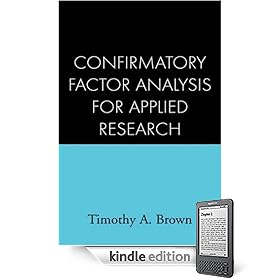Confirmatory Factor Analysis for Applied Research By Timothy A. Brown 以前有人发过,不过附件没有书,因此也是论坛的新书了。factor analysis大家经常用,但是真正用的正确,用的明白的并不多,为了大家对Factor analysis 的学习,就收1块钱吧。

Publisher: The Guilford Press
Number Of Pages: 475
Publication Date: 2006-03-29
ISBN-10 / ASIN: 1593852754
ISBN-13 / EAN: 9781593852757
Editorial Reviews
Review
"I found the author’s coverage of confirmatory factor analysis (CFA) both clear and accurate. I thought the explanations were pitched at the right level of mathematical and statistical complexity for the intended audience. In fact, the coverage of certain topics/m-/such as the problem of empirical underidentification and the computation of determinants and their functional significance in the assessment of global model fit/m-/is among the best I’ve read. This is a book that students will be glad to have on their shelves when they turn to their own data later on."--Christopher M. Federico, Department of Psychology and Department of Political Science, University of Minnesota
"Compared to other books, this book offers a lot of details which would facilitate better understanding of confirmatory factor analysis (CFA). The author is very good at explaining a lot of processes by examples, and includes clear figures and tables. I definitely recommend it to instructors who teach a course on CFA, especially for students who are not in quantitative psychology."--Ke-Hai Yuan, Department of Psychology, University of Notre Dame
"I confidently recommend this book to any colleague teaching a course in confirmatory factor analysis (CFA), structural equation modeling, or scale development. The text will also be an invaluable resource for applied researchers, due to the quantity and quality of the information it contains. Included are very clear explanations of the 'thick' technical terminology and excellent elaboration on the shortcomings of the previously published CFA research within the past 10-15 years. Other strengths are clearly written chapters on higher order analyses and multitrait-multimethod models; clear coverage of conducting CFA with missing data and conducting reliability analysis within the general framework of SEM, providing a very defensible and unified approach to the issues of reliability and validity during the process of scale/instrument development; and strategies for data screening and dealing with nonnormally distributed data."--Larry Price, Doctoral Program in Education, Texas State University-San Marcos
"For each chapter, Brown provides a comprehensive review of the topic by providing a clear commentary on the issues. He enhances this commentary with equations where necessary, illustrations, and numerical examples....The book delivers on its promise. It provides a comprehensive review of CFA techniques as a collection of essential tools that serve the contemporary researcher....The statistically sophisticated reader is provided with a current review of the appropriate use of these techniques....It could be used in an upper level graduate methodology course or by the active researcher who wishes to expand his or her repertoire of empirical techniques."--
APA PsycCRITIQUES
"This user-friendly guide to confirmatory factor analysis provides information and examples to help students and researchers through most any methodological situation. An abundance of practical advice on options for analyses, data issues, and reading and interpreting the data output make this a useful guide for almost anyone. Graduate students will find this an especially worthwhile addition to their statistical education and it would be a valuable course textbook for professors...4 stars!"--
Doody's Review Service
Product Description
Emphasizing practical and theoretical aspects of confirmatory factor analysis (CFA) rather than mathematics or formulas, Timothy A. Brown uses rich examples derived from the psychology, management, and sociology literatures to provide in-depth treatment of the concepts, procedures, pitfalls, and extensions of CFA methodology. Chock full of useful advice and tables that outline the procedures, the text shows readers how to conduct exploratory factor analysis (EFA) and understand similarities to and differences from CFA; formulate, program, and interpret CFA models using popular latent variable software packages such as LISREL, Mplus, Amos, EQS, and SAS/CALIS; and report results from a CFA study. Also covered are extensions of CFA to traditional IRT analysis, methods for determining necessary sample sizes, and new CFA modeling possibilities, including multilevel factor models and factor mixture models. Special features include a Web page offering data and program syntax files for many of the research examples so that readers can practice the procedures described in the book with real data. The Web page also includes links to additional CFA-related resources.
目录
1 • Introduction 1
Uses of Confirmatory Factor Analysis / 1
Psychometric Evaluation of Test Instruments / 1
Construct Validation / 2
Method Effects / 3
Measurement Invariance Evaluation / 4
Why a Book on CFA? / 5
Coverage of the Book / 6
Other Considerations / 8
Summary / 11
2 • The Common Factor Model
and Exploratory Factor Analysis
12
Overview of the Common Factor Model / 12
Procedures of EFA / 20
Factor Extraction / 21
Factor Selection / 23
Factor Rotation / 30
Factor Scores / 36
Summary / 37
3 • Introduction to CFA 40
Similarities and Differences of EFA and CFA / 40
Common Factor Model / 40
Standardized and Unstandardized Solutions / 41
Indicator Cross-Loadings/Model Parsimony / 42
Unique Variances / 46
Model Comparison / 47

 扫码加好友,拉您进群
扫码加好友,拉您进群